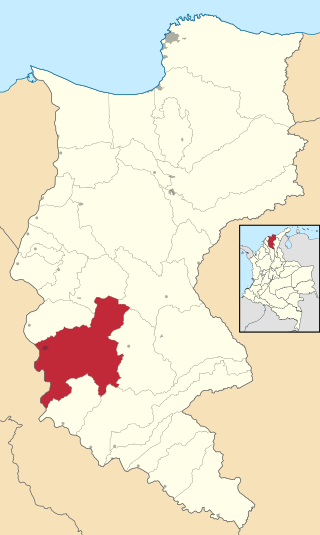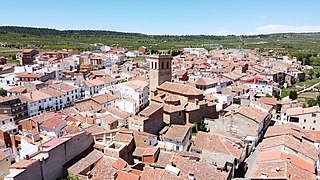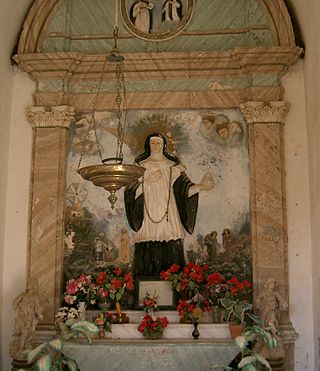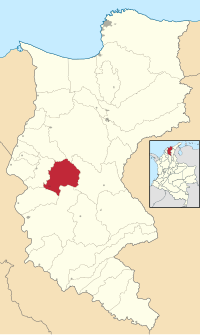
The Archipelago of San Andrés, Providencia and Santa Catalina, or San Andrés and Providencia, is one of the departments of Colombia, and the only one located geographically in Central America. It consists of two island groups in the Caribbean Sea about 775 km northwest of mainland Colombia, and eight outlying banks and reefs. The largest island of the archipelago and Colombia is called San Andrés and its capital is San Andrés. The other large islands are Providencia and Santa Catalina Islands which lie to the north-east of San Andrés; their capital is Santa Isabel.

Tepoztlán is a town in the central Mexican state of Morelos. It is located at 18°59′07″N99°05′59″W in the heart of the Tepoztlán Valley. The town serves as the seat of government for the municipality of the same name. The town had a population of 14,130 inhabitants, while the municipality reported 41,629 inhabitants in the 2010 national census.

Espinal is a Colombian municipality and town located in the Department of Tolima, 146 km southwest from Bogotá. It is the second most important town of the department and is the rice capital of the center of the country. It is flanked by the Magdalena and Coello rivers. El Espinal is known for the manufacture of typical musical instruments and its cuisine is known for tamales and the suckling pig, which are the typical dishes of the region. It has a total area of 231 km2, an urban area of 4.26 km2, and a rural area of 212.74 km2.
Siquinalá is a town, with a population of 18,150, and a municipality in the Escuintla department of Guatemala. The population of the municipality is 22,968. The municipality is located 81 km from Guatemala City, situated between the municipalities of Escuintla, Santa Lucía Cotzumalguapa, and La Democracia, linked to Siquinalá by road, which continues to the sea at Sipacate, in the municipality of La Gomera.

Guatapé is a town and municipality in the Department of Antioquia, Colombia. It is a part of the subregion of Eastern Antioquia and is located 79 kilometres (49 mi) from Medellín, the capital of the department. Guatapé is bordered on the north by Alejandría, San Rafael to the east, and Granada and El Peñol to the south. This town is the gathering place for Las Vegas, referring to the small farms of the area.

Aguachica, is a small city and municipality in the southern region of the Cesar Department, Colombia. There is no historical support on the date of its foundation; however, August 16, 1748 has been chosen by the community. Saint Roch is the patron saint of the municipality and August 16 is the date on which the Catholic Church celebrates its festival.

Ciénaga is a municipality and city in the Magdalena Department, Colombia, the second largest population center in this department, after the city of Santa Marta. It is situated at 11° 00' North, 74° 15' West, between the Sierra Nevada de Santa Marta, the Caribbean Sea and the Ciénaga Grande de Santa Marta marsh in northern Colombia. The city is situated in the northern part of Magdalena, 35 km from Santa Marta. According to estimations in 2020, the city had a population of 110,303. The mean annual temperature is 34 °C.

The Ciénaga Grande de Santa Marta is the largest of the swampy marshes located in Colombia between the Magdalena River and the Sierra Nevada de Santa Marta. It has an area of 4280 km2 and belongs to the outer delta system of the Madgalena River. It is separated from the Caribbean Sea by a narrow, sandy artificial spit built in the 1950s, on which is situated coastal route 90 from Barranquilla to Santa Marta. The marsh's large lagoon is connected to the Caribbean Sea via a narrow strait located between the town of Pueblo Viejo and the city of Ciénaga.

El Piñón is a town and municipality of the Colombian Department of Magdalena. Officially founded in 1760 by Francisco Sayas, Ignacio Crespo, Vicente De la Hoz and others. On April 20, 1915 was proclaimed a municipality. Its economy is based on agriculture and farming. Its main tourist attraction is the Iglesia San Pedro Mártir and the Ave Maria Monument. The town celebrates carnivals, the Saint Peter of Verona Day in April, El Milagroso in September, the Unedited Song Festival and the Decimates Festival.

Fundación is a town and municipality of the Colombian Department of Magdalena. Its people are known as Fundanenses. The primary economic activity is livestock-raising, for production of both meat and milk. Other crops are: corn, yuca, oranges, bananas, beans, sesame, sorghum, rice, tomatoes, and tobacco. There is also artisanal fishing.

Pedraza is a town and municipality of the Colombian Department of Magdalena.

Salamina is a town and municipality in the Department of Magdalena, northern Colombia.

Plato is a town and municipality in Magdalena Department in Colombia.

Sabanas de San Ángel, Spanish for Savannas of Saint Angel, is a town and municipality of the Colombian Department of Magdalena. Founded around 1607 with the name San Antoñito by the Spanish Colonizers as a pathway town in the route between La Guajira Department and the Magdalena River. On June 24, 1999 the municipality is created with the name of Sabanas de San Angel that segregated from the municipalities of Ariguaní, Pivijay, Chibolo and Plato.

Pinto or Santa Bárbara de Pinto is a town and municipality of the Magdalena Department in northern Colombia.

Aras de los Olmos is a municipality of Valencia, Spain. Belonging to the province of Valencia, in the region of Los Serranos.

The Cathedral of Cartagena de Indias in Colombia, officially the Metropolitan Cathedral Basilica of Saint Catherine of Alexandria, is located in the historic centre of Cartagena. It is the episcopal see of the Archbishop of Cartagena de Indias, one of the oldest episcopal sees in the Americas. The cathedral is dedicated to Saint Catherine of Alexandria.

The Santa Catalina de Alejandria Church, also referred to as the Arayat Church, is Renaissance-style Roman Catholic church in Arayat, Pampanga, Philippines. Since its initial construction during the late 1700s, it has been subjected to major alterations and changes such as addition of decorative ornaments and reliefs and re-painting works.

The Santa Catalina de Alejandria Parish Church, commonly known as the Tayum Church, is a 19th-century Baroque Roman Catholic church located at Brgy. Poblacion, Tayum, Abra, Philippines. The parish church, under the patronage of Saint Catherine of Alexandria, is under the jurisdiction of the Roman Catholic Diocese of Bangued. The church, together with 25 other Spanish-era churches, was declared a National Cultural Treasure by the National Museum of the Philippines in 2001. Its current parish priest is Fr. Roderick Ardaniel, who succeeded Fr. Ruben Valdez.

Catherine of Palma was a Spanish canon and mystic from Mallorca. She is venerated as a saint in the Roman Catholic Church and her feast day is commonly celebrated on 5 April although in her home town of Valldemossa she is remembered on the 27 and 28 of July.




















